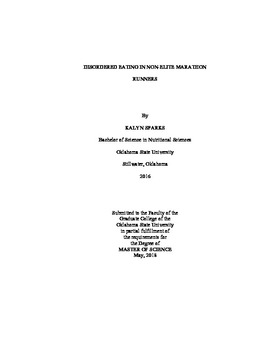| dc.contributor.advisor | Wollenberg, Gena Suela | |
| dc.contributor.author | Sparks, Kalyn Lee | |
| dc.date.accessioned | 2019-03-25T20:05:25Z | |
| dc.date.available | 2019-03-25T20:05:25Z | |
| dc.date.issued | 2018-05-01 | |
| dc.identifier.uri | https://hdl.handle.net/11244/317704 | |
| dc.description.abstract | The primary purpose of this study was to evaluate prevalence of disordered eating in non-elite marathon runners. Another purpose for this study was to analyze the difference in disordered eating prevalence between males and females, as well as, to evaluate the relationship of BMI categories and education levels with disordered eating. | |
| dc.description.abstract | The participants for this study were recruited through running club directors throughout the states of Oklahoma, Arkansas, and Texas via email. Running club directors sent an email containing the information sheet on the study procedures and a hyperlink to the Qualtrics survey. The participants were required to fill out a two-part survey that included anthropometrics, demographics, marathon information, and the EAT-26 questionnaire. | |
| dc.description.abstract | A total of 98 non-elite marathon runners participated in this study. There were 49 males and 49 females. Disordered eating risk was exhibited by 23 (23.5%) of the participants (EAT-26 ≥ 20). There was no significant difference in disordered eating risk (EAT-26 ≥ 20) between genders (p = .057) There was also no significant difference found in the EAT-26 subscales Dieting (D) (p = .221), Food Preoccupation (FP) (p = .133), and Oral Control (OC) (p = .062) between males and females. There was no significant difference found in EAT-26 total scores between the BMI categories, normal and overweight (p = .858). There was a significant relationship between the BMI categories and the subscale OC (p = .038). There was a significant negative correlation between BMI and subscale OC (r = -.228, p = .024). There was no significant difference found in EAT-26 total scores or subscales between the education levels (total p = .620; D p = .842, FP p = .227, and OC p = .600). | |
| dc.description.abstract | Non-elite marathon runners are a population that could benefit from dietary education, specifically education on binge eating. Further research should explore BMI and the subscale Oral Control. | |
| dc.format | application/pdf | |
| dc.language | en_US | |
| dc.rights | Copyright is held by the author who has granted the Oklahoma State University Library the non-exclusive right to share this material in its institutional repository. Contact Digital Library Services at lib-dls@okstate.edu or 405-744-9161 for the permission policy on the use, reproduction or distribution of this material. | |
| dc.title | Disordered Eating in Non-Elite Marathon Runners | |
| dc.contributor.committeeMember | Gates, Gail | |
| dc.contributor.committeeMember | Winterowd, Carrie | |
| osu.filename | Sparks_okstate_0664M_15585.pdf | |
| osu.accesstype | Open Access | |
| dc.description.department | Nutritional Sciences | |
| dc.type.genre | Thesis | |
| dc.type.material | text | |
